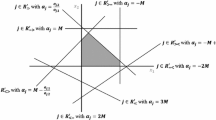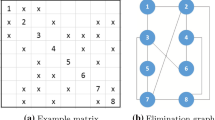Abstract
Recently, a linear programming problem solver, called dual projective simplex method, was proposed (Pan, Computers and Mathematics with Applications, vol. 35, no. 6, pp. 119–135, 1998). This algorithm requires a crash procedure to provide an initial (normal or deficient) basis. In this paper, it is recast in a more compact form so that it can get itself started from scratch with any dual (basic or nonbasic) feasible solution. A new dual Phase-1 approach for producing such a solution is proposed. Reported are also computational results obtained with a set of standard NETLIB problems.
Similar content being viewed by others
References
1._ E.M.L. Beale, “An alternative method for linear programming,” Proceedings of Cambridge Philosophical Society, vol. 50, pp. 513–523, 1954.
M. Benichou, J.M. Gauthier, G. Hentges, and G. Ribiere, “The efficient solution of linear programming problems—Some algorithmic techniques and computational results,” Mathematical Programming, vol. 13, pp. 280–322, 1977.
A. Bjorck, Numerical Methods for Least Squares Problems, SIAM, Philadelpha, 1996.
R.G. Bland, “New finite pivoting rules for the simplex method,” Mathematics of Operations Research, vol. 2, pp. 103–107, 1977.
A. Charnes, Optimality and degeneracy in linear programming, Econometrica, vol. 2, pp. 160–170, 1951.
G.B. Dantzig, Maximization of a linear function of variables subject to linear inequalities, in Activity Analysis of Production and Allocation, T.C. Koopmans (Ed.), John Wiley & Sons: New York, 1951, pp. 339–347.
G.B. Dantzig, A. Orden, and P. Wolfe, “The generalized simplex method for minimizing a linear form under linear inequality restraints,” Pacific Journal of Mathematics, vol. 5, pp. 183–195, 1955.
J.J.H. Forrest and D. Goldfarb, “Steepest-edge simplex algorithms for linear programming,” Mathematical Programming, vol. 57, pp. 341–374, 1992.
D.M. Gay, “Electronic mail distribution of linear programming test problems,” Mathematical Programming Society COAL Newsletter, vol. 13, pp. 10–12, 1985.
P.E. Gill, S.J. Hammarling, W. Murray, M.A. Saunders, and M.H. Wright, User's Guide for LSSOL (Version 1.0): A Fortran Package for Constrained Linear Least-Squares and Convex Quatratic Programming, Department of Engineeing Economic Systems & Operations Research, Stanford University, 1986.
W. Givens, “Computation of plane unitary rotations transforming a general matrix to triangular form,” SIAM J. App. Math., vol. 6, pp. 26–50, 1958.
G.H. Golub and C.F. Van Loan, Matrix Computations. John Hopkins University Press: Baltimore, MD, 1983.
W.W. Hager, “The LP Dual active set algorithm,” in High Performance Algorithms and Software in Nonlinear Optimization, R. De Leone et al. (Eds.), Kluwer, Dordrecht, 1998, pp. 243–254.
W.W. Hager, “The dual active set algorithm and its application to linear programming,” Computational Optimization and Applications, vol. 21, pp. 263–275, 2002.
W.W. Hager, C.-L. Shih, and E.O. Lundin, Active Set Strategies and the LP Dual Active Set Algorithm, Department of Mathematics, University of Florida, Gainesville, FL, Aug., 1996.
P.M.J. Harris, “Pivot selection methods of the Devex LP code,” Mathematical Programming Study, vol. 4, pp. 30–57, 1975.
B. Hattersley and J. Wilson, “A dual approach to primal degeneracy,” Mathematical Programming, vol. 42, pp. 135–145 1988.
A.J. Hoffman, Cycling in the simplex algorithm, Report No. 2974, Nat. Bur. Standards, Washington D.C., 1953.
P.-Q. Pan, Practical finite pivoting rules for the simplex method, OR Spektrum, vol. 12, pp. 219–225, 1990.
P.-Q. Pan, “A simplex-like method with bisection for linear programming,” Optimization, vol. 22, no. 5, pp. 717–743, 1991.
P.-Q. Pan, “A dual projective simplex method for linear programming,” Computers and Mathematics with Applications, vol. 35, no. 6, pp. 119–135, 1998a.
P.-Q. Pan, “A basis-deficiency-allowing variation of the simplex method,” Computers and Mathematics with Applications, vol. 36, no. 3, pp. 33–53, 1998b.
P.-Q. Pan, “A projective simplex method for linear programmming,” Linear Algebra and Its Applications, vol. 292, pp. 99–125, 1999.
P.-Q. Pan, “A projective simplex algorithm Using LU decomposition,” Computers and Mathematics with Applications, vol. 39, pp. 187–208, 2000.
P.-Q. Pan and Y.-P. Pan, “A phase-1 approach for the generalized simplex algorithm,” Computers and Mathematics with Applications, vol. 42, pp. 1455–1464, 2001.
Author information
Authors and Affiliations
Rights and permissions
About this article
Cite this article
Pan, PQ. A Dual Projective Pivot Algorithm for Linear Programming. Computational Optimization and Applications 29, 333–346 (2004). https://doi.org/10.1023/B:COAP.0000044185.69640.54
Issue Date:
DOI: https://doi.org/10.1023/B:COAP.0000044185.69640.54




